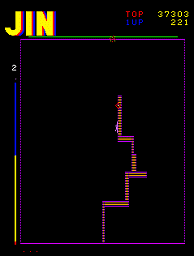 The Game: The player controls a marker, trying to claim as much of the playing field as possible by enclosing areas of it. Drawing boundaries faster is safer, but yields fewer points. A slower draw, which leaves the marker vulnerable to attack from the Jin and from the enemies in hot pursuit of the marker’s every move, is worth many more points upon the completion of an enclosed area. If the ever-shifting Jin touches the marker or an uncompleted boundary it is drawing, a “life” is lost and the game starts again. (Falcon, 1982)
The Game: The player controls a marker, trying to claim as much of the playing field as possible by enclosing areas of it. Drawing boundaries faster is safer, but yields fewer points. A slower draw, which leaves the marker vulnerable to attack from the Jin and from the enemies in hot pursuit of the marker’s every move, is worth many more points upon the completion of an enclosed area. If the ever-shifting Jin touches the marker or an uncompleted boundary it is drawing, a “life” is lost and the game starts again. (Falcon, 1982)
Memories: Not content merely to copy Donkey Kong in the form of Crazy Kong (though that game was actually Nintendo-licensed for distribution in Far East markets outside Japan, and never intended to wind up in North America, though it did anyway), bootleg maker Falcon diversified its offerings by copying another Japanese game maker, unapologetically turning Taito‘s Qix into Jin. But for some bizarre reason, Falcon used a different game’s hardware to do this.
 Hardware hacks weren’t entirely uncommon in the world of arcade knockoffs; Pac-Man could be modified to run on Galaxian boards, for example, with some changes made to the display to account for Galaxian‘s color palette. Jin very strangely rendered its Qix clone on Williams hardware, resulting in something slightly more colorful than the original Qix color palette, but slow-moving and punctuated by sound effects familiar to anyone who had spent some quality time with Defender.
Hardware hacks weren’t entirely uncommon in the world of arcade knockoffs; Pac-Man could be modified to run on Galaxian boards, for example, with some changes made to the display to account for Galaxian‘s color palette. Jin very strangely rendered its Qix clone on Williams hardware, resulting in something slightly more colorful than the original Qix color palette, but slow-moving and punctuated by sound effects familiar to anyone who had spent some quality time with Defender.
Was there really a market for conversion boards that would let arcade operators with Defender machines – a perennially popular shoot-’em-up – turn their cabinets into Qix clones? There’s also a possibility that  Falcon had a licensing deal with Taito similar to the deal struck with Nintendo for Crazy Kong.
Falcon had a licensing deal with Taito similar to the deal struck with Nintendo for Crazy Kong.
In the end, Jin is a relic of a time when the arcade business was booming so hard that nearly anyone could think of a way to cash in – or at least to try.

